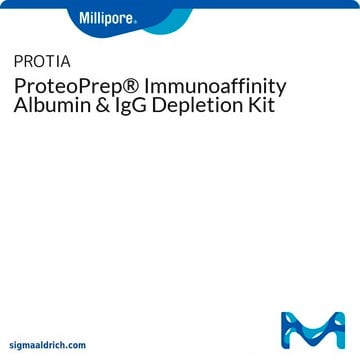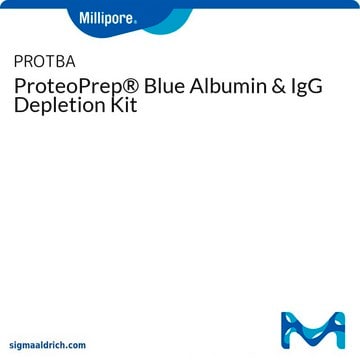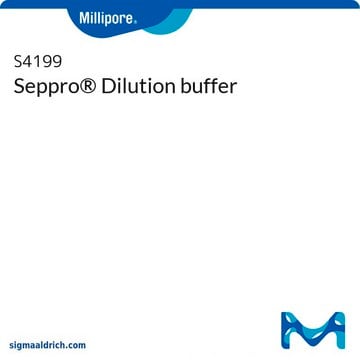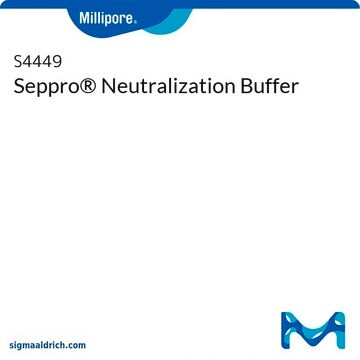SEP010
Seppro® IgY14
Spin Columns
Anmeldenzur Ansicht organisationsspezifischer und vertraglich vereinbarter Preise
Alle Fotos(1)
About This Item
UNSPSC-Code:
12352200
NACRES:
NA.32
Empfohlene Produkte
Kapazität
1 mg total protein loading(14 μL of human plasma, average human protein concentration 70 mg/mL)
Lagertemp.
2-8°C
Suchen Sie nach ähnlichen Produkten? Aufrufen Leitfaden zum Produktvergleich
Allgemeine Beschreibung
Seppro® IgY14-Säulen ermöglichen die Trennung von 14 hochabundanten Proteinen (HAP) aus Plasmaprotein-Mischungen. Die aviären polyklonalen IgY (Immunglobulin aus Eigelb)-Antikörper bieten aufgrund ihrer hochspezifischen Partitionierungseigenschaften wesentliche Vorteile gegenüber Konkurrenzprodukten, da den Forschern deutlich reinere humane Proteinmischungen zur Verfügung stehen. Darüber hinaus erleichtern Seppro®-Säulen Proteomanalysen am Plasmaproteom und sorgen für reinere Ergebnisse.
Abgereicherte Proteine:
Albumin
IgG
α1-Antitrypsin
IgA
IgM
Transferrin
Haptoglobin
α2-Macroglobulin
Fibrinogen
Komplement C3
α1-saures Glykoprotein (Orosomucoid)
HDL (Apolipoproteine A-I und A-II)
LDL (vorwiegend Apolipoprotein B)
Abgereicherte Proteine:
Albumin
IgG
α1-Antitrypsin
IgA
IgM
Transferrin
Haptoglobin
α2-Macroglobulin
Fibrinogen
Komplement C3
α1-saures Glykoprotein (Orosomucoid)
HDL (Apolipoproteine A-I und A-II)
LDL (vorwiegend Apolipoprotein B)
Anwendung
Seppro® IgY14, Spin-Säulen (Kapazität: 15-20 μl) zur Verwendung als Basis für die Entfernung von Plasma-/Serumprotein nach der Affinitätsentfernung von 14 hochabundanten Proteinen (HAP) aus humanen Plasmaproteingemischen mittels Flüssigkeitschromatographie. Seppro® IgY14 wird unterstützend in der Analyse von niedrigabundanten Proteinen im humanen Serum/Plasma verwendet.
Rechtliche Hinweise
Seppro is a registered trademark of Merck KGaA, Darmstadt, Germany
Kit-Komponenten auch einzeln erhältlich
Produkt-Nr.
Beschreibung
SDB
Lagerklassenschlüssel
10 - Combustible liquids
Analysenzertifikate (COA)
Suchen Sie nach Analysenzertifikate (COA), indem Sie die Lot-/Chargennummer des Produkts eingeben. Lot- und Chargennummern sind auf dem Produktetikett hinter den Wörtern ‘Lot’ oder ‘Batch’ (Lot oder Charge) zu finden.
Besitzen Sie dieses Produkt bereits?
In der Dokumentenbibliothek finden Sie die Dokumentation zu den Produkten, die Sie kürzlich erworben haben.
Hoi Pang Low et al.
Genomics, proteomics & bioinformatics, 11(6), 335-344 (2013-12-04)
Preeclampsia, a complication of pregnancy characterized by hypertension and proteinuria, has been found to reduce the subsequent risk for breast cancer in female offspring. As this protective effect could be due to exposure to preeclampsia-specific proteins during intrauterine life, the
Maneesh Bhargava et al.
PloS one, 9(10), e109713-e109713 (2014-10-08)
Acute Respiratory Distress Syndrome (ARDS) continues to have a high mortality. Currently, there are no biomarkers that provide reliable prognostic information to guide clinical management or stratify risk among clinical trial participants. The objective of this study was to probe
Inmaculada Lopez-Font et al.
Molecular neurobiology, 56(12), 8603-8616 (2019-07-11)
The β-site amyloid precursor protein cleaving enzyme 1 (BACE1) is the main brain β-secretase responsible for the amyloidogenic processing of the amyloid precursor protein (APP). Previous studies have suggested that cerebrospinal fluid (CSF) β-secretase activity may be a candidate diagnostic
Chien-Lun Chen et al.
Journal of proteomics, 85, 28-43 (2013-05-02)
In this study, we evaluated the reproducibility of abundant urine protein depletion by hexapeptide-based library beads and an antibody-based affinity column using the iTRAQ technique. The antibody-based affinity-depletion approach, which proved superior, was then applied in conjunction with iTRAQ to
Majlinda Kullolli et al.
Journal of chromatography. B, Analytical technologies in the biomedical and life sciences, 939, 10-16 (2013-10-05)
Human plasma is a commonly used diagnostic fluid in clinical chemistry. In-depth plasma proteomic analysis is performed to search for disease biomarkers, however the large dynamic range of protein abundance in plasma presents a substantial analytical challenge. Removal of abundant
Unser Team von Wissenschaftlern verfügt über Erfahrung in allen Forschungsbereichen einschließlich Life Science, Materialwissenschaften, chemischer Synthese, Chromatographie, Analytik und vielen mehr..
Setzen Sie sich mit dem technischen Dienst in Verbindung.






